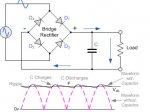170626-0833 EDT
To add to my plots of yesterday.
These plots show the effect of adding some filter capacitance in parallel with the resistive load. The resistance is 5 ohms, and the capacitance is about 1100 ufd.
Plot 4. Transformer output voltage, red, and voltage across the parallel combination of resistor and capacitor after the diode, blue.
The capacitor does not fully discharge before the next positive half wave voltage starts.
At 8 milliseconds before the screen center there is a dip in the source voltage resulting from current flow starting to the capacitor-resistor and the resulting voltage drop within the transformer from its equivalent series resistance and inductance.
At abour 2.6 milliseconds before center there is a step change in voltage. This is where diode conduction turns off.
View attachment 17865
,
Plot 5. Transformer output voltage, same as input to diode, red, and diode current, blue.
The current curve is probably showing a resonant effect from the transformer leakage inductance and the filter capacitor. The step change in source voltage is clearly shown as occurring when diode current stops.
View attachment 17866
,
Plot 6. Capacitor-resistor voltage, red, and diode current, blue.
View attachment 17867
,
,
,





